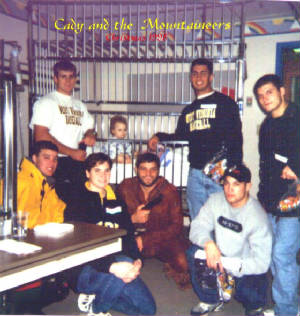|

Cady with The WVU Mountaineer and other members of various WVU teams.
In the beginning there were trips to Morgantown every two weeks for check ups and hospital admissions about
every two months. The check ups tapered down to every six months and then every year. When Cady was about 2, the
admissions tapered down to about 2 a year. She had a bad year the year she began Kindergarten. It was a huge shock
to her system, going to school all day, five days a week, getting up at 5:30 am to catch the bus for an hour long ride, not
getting home until almost 4 p.m. after another hour long ride. She decompensated in October, again over Christmas and
finally in February she got pneumonia and had a 7 day stay. She came home for about a week after that episode, and then
contracted pancreatitis. That earned her another 7-10 day stay. One good thing that happened with these two February
stays was that they didn't trigger her PA, she weathered these two conditions as if she were a normal child. These were
also, to date, the last time she's been admitted to the hospital. That was February 2003.
Cady's diet
Cady's diet is one of my own concoction. Her first feeding every day is a fruit feeding and meat is
the protein. She can have 3g of protein per kg of body weight per day. I mix up a can of peaches or pears, 1/2
jar of baby food meat, some vitamin C, some Iron, some Polyvifluoride, some papaya and some L-Carnitine, and kool-aid.
This makes two days worth of breakfast. Her 2nd and 4th feedings per day are made of Propimex-2, cheerios, papaya, canola
oil, multivitamins, vitamin E and fish oil. This is mixed in frozen concentrated orange juice reconstituted with Eater's
Digest tea instead of water. Her 3rd feeding each day is made of a can of beets, green beans or carrots. I add
4T of yogurt, some stool softener, papaya tabs and L-Carnitine. This too is mixed in a base of kool-aid. Cady
is g-tube fed four times a day, each feeding four hours apart.
Cady takes iron because she is anemic. The iron is mixed in the fruit feeding with the vitamin C because
iron is best absorbed where vitamin C and a meat substance is present. She takes polyvifluorde because the city water
where we live doesn't have enough fluoride in it. She takes L-Carnitine because the propionyl co-a carboxylase enzyme
she is deficient in does not make enough for her to carry away the toxins caused by protein metabolism. There is papaya
in every feeding because Cady is plagued with nausea and vomiting on a routine basis. She even had a Nissenfundoplication
done at 17 months with her g-tube placement to try to curtail the vomiting. Yogurt is used as the protein in her evening
feedings to try to control the yeast infections she is susceptible to because of the increased pH of her urine/sweat.
Stool softeners prevent constipation that ultimately would drive up her ammonia level.
Every night before she goes to bed, Cady takes 10mg of Biotin, which helps the PCC enzyme work better.
|

